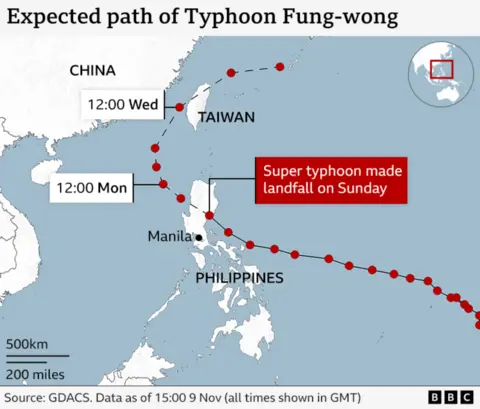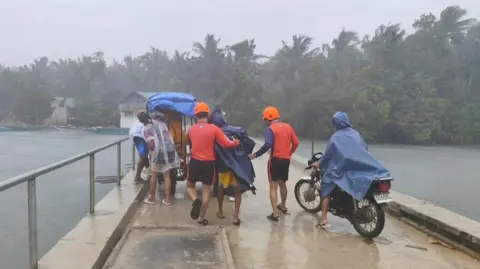Kathryn Armstrong,
André Rhoden-Paul and
Lulu Luo,Aurora, Philippines
Typhoon Fung-wong has made landfall in the Philippines, where more than 900,000 people have been evacuated and two people have died.
The storm was upgraded to a super typhoon before landfall, with sustained winds of around 185 km/h (115mph) and gusts of 230km/h (143mph).
The eye of the storm hit Aurora province in Luzon – the Philippines’s most populous island – at 21:10 local time (13:10 GMT). The country’s meteorological service warned of destructive winds and “high-risk of life-threatening and damaging storm surge” as the typhoon moves north-westerly across Luzon.
Fung-wong – known locally as Uwan – comes days after an earlier storm, Kalmaegi, left devastation and nearly 200 people dead.

Eastern parts of the Philippines had already begun experiencing heavy rains and winds on Saturday evening, a weather official said.
Residents in Catanduanes, an island in the east of the Bicol region, as well as in other low-lying and coastal areas, had been urged to move to higher ground by Sunday morning.
The storm passed near the eastern Bicol region on Sunday morning, before making its way past the Polillo Islands on Sunday afternoon.
The civil defence office reported that one person drowned and firefighters recovered the body of a woman trapped under debris in Catbalogan City.
The civil aviation regulator has closed several airports, and almost 300 flights have been cancelled.
Fung-wong was expected to weaken after making landfall, but is likely to remain a typhoon as it travels over Luzon.
More than 200mm of rain is forecast for parts of Luzon, with even 100-200mm in the Metro Manilla area. This is expected to cause severe flooding and landslides.
 CHARISM SAYAT/AFP via Getty Image
CHARISM SAYAT/AFP via Getty ImageIn the Aurora region, in eastern Luzon, BBC News spoke to Hagunoy, 21, who works at one of the dozen hotels which line the coast in Sabang.
He said police had repeatedly visited in recent days to ensure all guests were evacuated ahead of the storm. The hotels were all deserted on Sunday morning.
While the tide had risen sharply, Hagunoy said he would stay as long as he could to guard the property, before riding his motorbike home to safety.
Staff had secured the gates and tied windows shut with rope to try to stop the glass from shattering in the wind.
 EPA/Shutterstock
EPA/ShutterstockIn central Aurora, more than 200 people arrived at a shelter in a sports centre. Many parents have brought young children, too young to remember Typhoon Haiyan, which killed more than 6,000 people when it struck the Philippines in 2013.
“We felt very worried because of the strength of the typhoon, and we have young children to think of,” Jessa Zurbano told the BBC.
Another evacuee Patry Azul said: “Our house is made of wood and flimsy materials. We live close to the sea so we didn’t feel safe.”
Fung-wong has also forced the suspension of rescue operations following the passage of Kalmaegi, one of the strongest typhoons this year.
Heavy rainfall sent torrents of mud down hillsides and into residential areas. Some poorer neighbourhoods were obliterated by the fast-moving flash floods.
At least 204 people are now known to have died in the Philippines as a result of the earlier storm, while more than 100 are still missing.
Five people also died in Vietnam, where strong winds uprooted trees, tore off roofs, and smashed large windows.

The Filipino government declared a state of calamity across the country after Typhoon Kalmaegi and in preparation for the coming storm.
It has given government agencies more power to access emergency funds and fast-track deliveries of essential goods and services.
For some Filipinos, the devastation wrought by Kalmaegi has left them even more anxious about the storm to come.
“We decided to evacuate because the recent typhoon brought floods in our area, and now I just want to keep my family safe,” Norlito Dugan told the AFP news agency.
He is among those who have taken shelter in a church in the city of Sorsogon in Luzon.
Another resident, Maxine Dugan said: “I’m here because the waves near my house are now huge.”
The Philippines – located near the area where Pacific Ocean tropical weather systems form – is one of the most vulnerable countries in the world to cyclones.
About 20 tropical cyclones form in that region every year, half of which affect the country directly.
Climate change is not thought to increase the number of hurricanes, typhoons and cyclones worldwide.
However, warmer oceans coupled with a warmer atmosphere – fuelled by climate change – have the potential to make those that do form even more intense. That can potentially lead to higher wind speeds, heavier rainfall, and a greater risk of coastal flooding.

